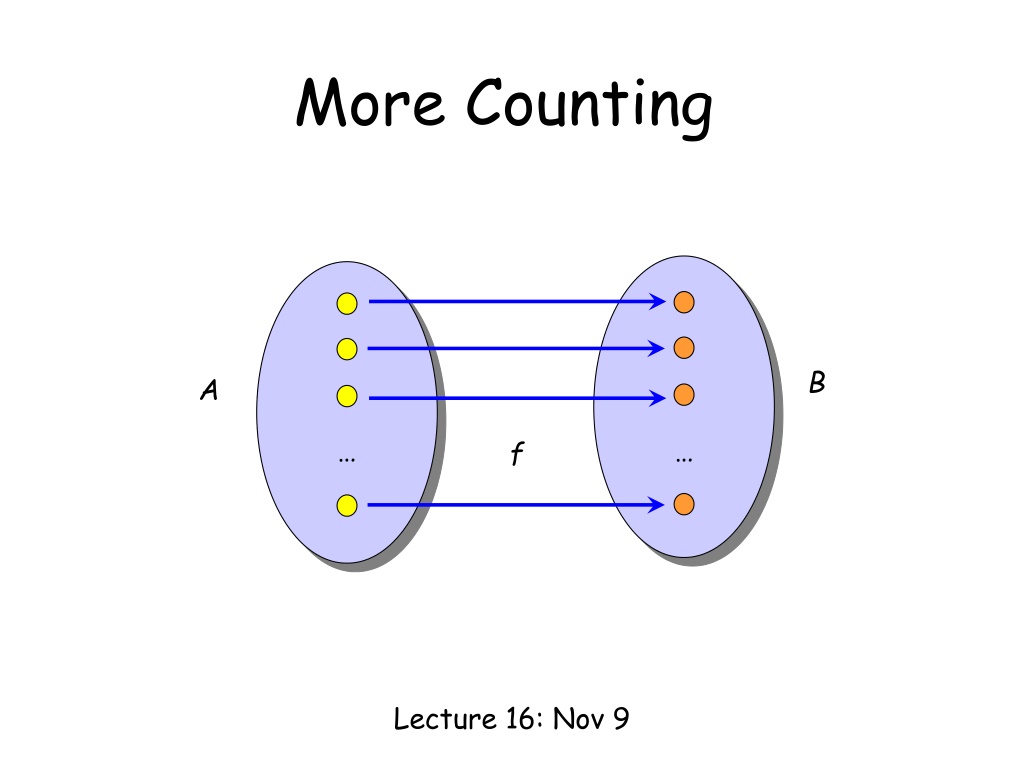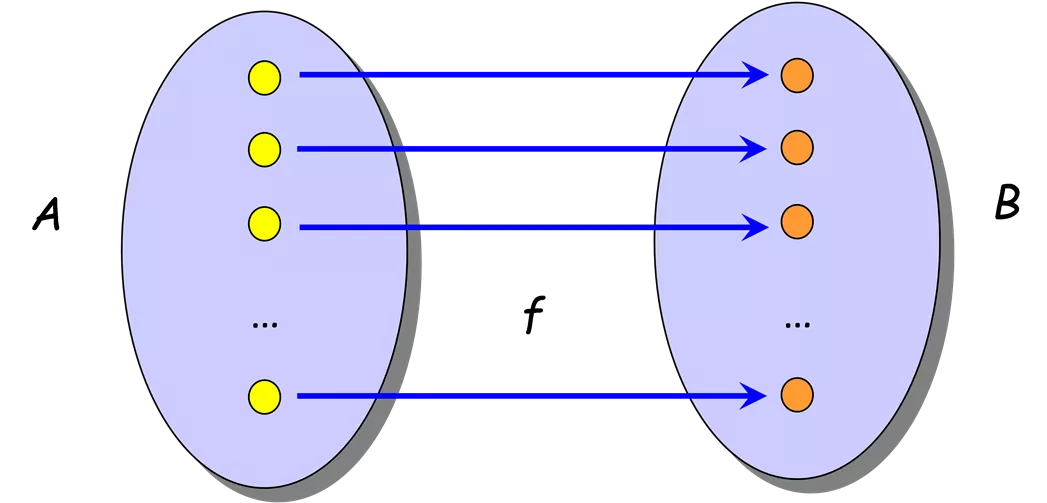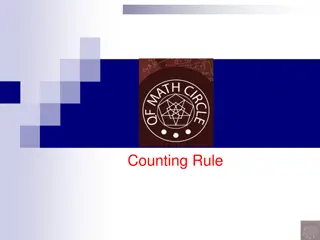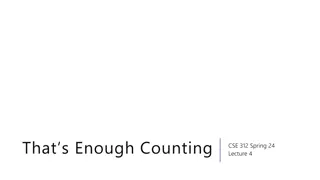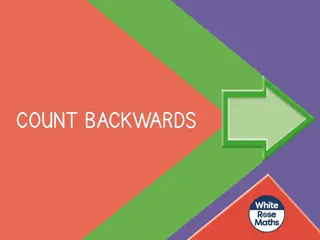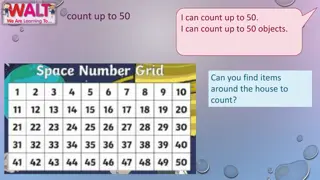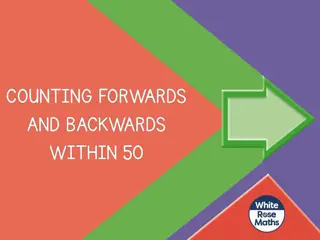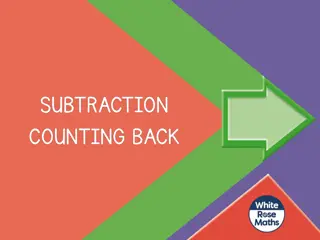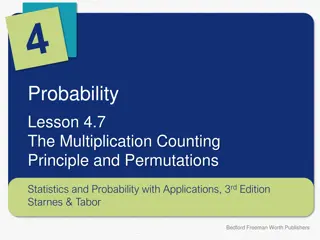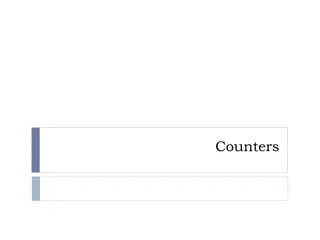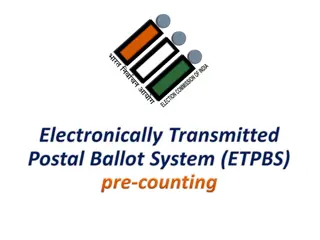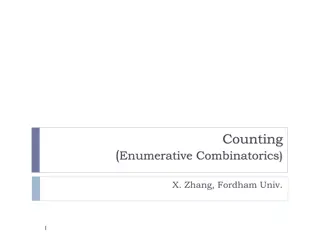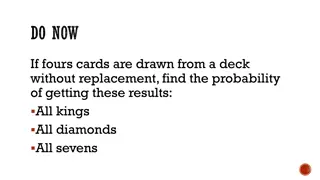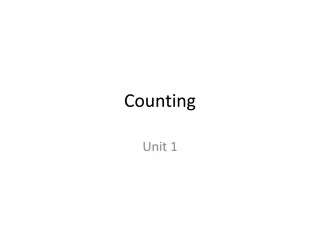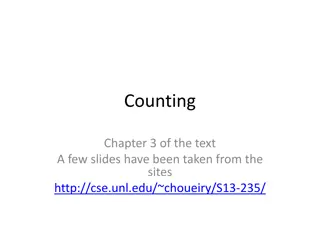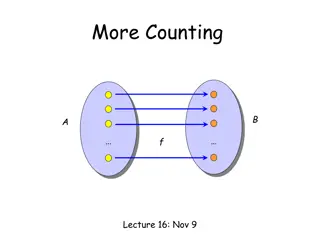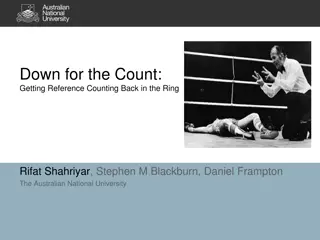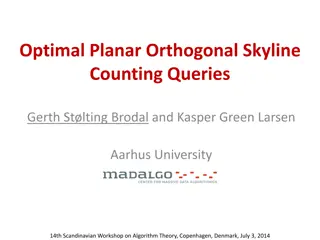More Counting
In this lecture, we explore various counting rules such as bijection and the division rule. We study the power set of a set and how to define mappings between subsets and binary strings. Additionally, we delve into a chess problem involving the placement of a pawn, knight, and bishop on a chessboard with specific constraints. Through bijections and configurations, we analyze the possible ways to arrange these pieces without conflicts.
Download Presentation

Please find below an Image/Link to download the presentation.
The content on the website is provided AS IS for your information and personal use only. It may not be sold, licensed, or shared on other websites without obtaining consent from the author. Download presentation by click this link. If you encounter any issues during the download, it is possible that the publisher has removed the file from their server.
E N D
Presentation Transcript
More Counting B A f Lecture 16: Nov 9
This Lecture We will study how to define mappings to count. There will be many examples shown. Bijection rule Division rule More mapping
Counting Rule: Bijection If f is a bijection from A to B, then |A| = |B| B A f
Power Set How many subsets of a set S? P(S) = the power set of S = the set of all subsets of S for S = {a, b, c}, P(S) = { , {a}, {b}, {c}, {a,b}, {a,c}, {b,c}, {a,b,c} } Suppose S has n elements. How large is the power set of S?
Bijection: Power Set and Binary Strings S: {s1, s2, s3, s4, s5, , sn} We define a bijection between subsets and binary strings A: the set of all subsets of S A B B: the set of all binary strings of length n f The mapping is defined in the following way: subset: {s1, s3, s4, , sn} string: 1 0 1 1 0 1
Bijection: Power Set and Binary Strings The mapping is defined in the following way: subset: {s1, s3, s4, , sn} A B f string: 1 0 1 1 0 1 This mapping is a bijection, because each subset is mapped to a unique binary string, and each binary string represents a unique subset. Therefore, |A| = |B|, and |B| can be computed directly. So, |n-bit binary strings| = |P(S)|
A Chess Problem In how many different ways can we place a pawn (p), a knight (k), and a bishop (b) on a chessboard so that no two pieces share a row or a column?
A Chess Problem We define a mapping between configurations to sequences (r(p), c(p), r(k), c(k), r(b), c(b)), where r(p), r(k), and r(b) are distinct rows, and c(p), c(k), and c(b) are distinct columns. A: the set of the configurations of the 3 pieces A B B: the set of the such sequences of 6 numbers f If we can define a bijection between A and B, and also calculate |B|, then we can determine |A|.
A Chess Problem We define a mapping between configurations to sequences (r(p), c(p), r(k), c(k), r(b), c(b)), where r(p), r(k), and r(b) are distinct rows, and c(p), c(k), and c(b) are distinct columns. (7,6,2,5,5,2) (2,5) This is a bijection, because: each configuration is mapped to a unique sequence each sequence represents a unique configuration. (5,2) So, to count the number of chess configurations, it is enough to count the number of such sequences. (7,6)
A Chess Problem We define a mapping between configurations to sequences (r(p), c(p), r(k), c(k), r(b), c(b)), where r(p), r(k), and r(b) are distinct rows, and c(p), c(k), and c(b) are distinct columns. Using the generalized product rule, there are 8 choices of r(p) and c(p), there are 7 choices of r(k) and c(k), there are 6 choices of r(b) and c(b). Thus, total number of configurations = (8x7x6)2= 112896. (7,6,2,5,5,2)
Counting Doughnut Selections There are five kinds of doughnuts. How many different ways to select a dozen doughnuts? 00 (none) 000000 00 00 Chocolate Lemon Sugar Glazed Plain A ::= all selections of a dozen doughnuts Hint: define a bijection! A B f
Counting Doughnut Selections A ::= all selections of a dozen doughnuts B::= all 16-bit binary strings with exactly four 1 s. Define a bijection between A and B. 0011000000100100 00 1 1 000000 1 00 1 00 00 (none) 000000 00 00 Chocolate Lemon Sugar Glazed Plain Each doughnut is represented by a 0, and four 1 s are used to separate five types of doughnuts.
Counting Doughnut Selections c chocolate, l lemon, s sugar, g glazed, p plain maps to a bijection 0c10l10s10g10p A ::= all selections of a dozen doughnuts B::= all 16-bit binary strings with exactly four 1 s. = A B
Choosing Non-Adjacent Books There are 20 books arranged in a row on a shelf. How many ways to choose 6 of these books so that no two adjacent books are selected? A ::= all selections of 6 non-adjacent books from 20 books A Hint: define a bijection! B f
Choosing Non-Adjacent Books A ::= all selections of 6 non-adjacent books from 20 books B::= all 15-bit binary strings with exactly six 1 s. Map each zero to a non-chosen book, each of the first five 1 s to a chosen book followed by a non-chosen book, and the last 1 to a chosen book. This is a bijection, because: each selection maps to a unique binary string. each binary string is mapped by a unique selection.
Choosing Non-Adjacent Books A ::= all selections of 6 non-adjacent books from 20 books B::= all 15-bit binary strings with exactly six 1 s. = A B
In-Class Exercise for i=1 to n do for j=1 to i do for k=1 to j do printf( hello world\n ); How many hello world will this program print?
In-Class Exercise for i=1 to n do for j=1 to i do for k=1 to j do printf( hello world\n ); There are n possible positions for the i,j,k. 1 2 3 4 5 n Imagine there are n-1 separators for the n numbers. If i=4, j=2, k=2, then there are two balls in 2 and one ball in 4.
In-Class Exercise for i=1 to n do for j=1 to i do for k=1 to j do printf( hello world\n ); There are n possible positions for the i,j,k. 1 2 3 4 5 n There is a bijection between the positions for i,j,k and the set of strings with n-1 ones and 3 zeros. So, the program prints hello world exactly times.
In-Class Exercises How many solutions are there to the equation x1+x2+x3+x4=10, where x1,x2,x3,x4 are nonnegative integers? Think of this as distributing 10 points amongst 4 variables. x1 x2 x3 x4 0 0 0 0 0 0 0 0 0 0 Suppose x1=3, x2=5, x3=2, x4=0, it corresponds to inserting 3 separations as above.
In-Class Exercises How many solutions are there to the equation x1+x2+x3+x4=10, where x1,x2,x3,x4 are nonnegative integers? Think of this as distributing 10 points amongst 4 variables. x1 x2 x3 x4 0 0 0 0 0 0 0 0 0 0 So there is a bijection between the integer solutions and the set of binary strings with 10 zeros and 3 ones. So, the are exactly integer solutions.
In-Class Exercises How many integer solutions to x1+x2+x3+x4=10 if each xi>=1? Method 1: Define a mapping directly, using the idea of non-adjacent books. Method 2: Set xi=yi+1. So the equation becomes y1+y2+y3+y4=6, where each yi is a non-negative integer. Therefore we can apply the previous result, and conclude that the answer is
This Lecture Bijection rule Division rule More mapping
Division Rule if function from A to B is k-to-1, then A = k B (generalizes the Bijection Rule)
Example 3: Two Pairs This is something we have encountered before when we counted poker hands. Double Count! A: the set of two pairs B: the set of sequences which satisfy (1)-(6). What we did was to show that the mapping from A to B is 1-to-2, and thus conclude that 2|A| = |B|. Then we compute |B| and then |A|. 25
Another Chess Problem In how many different ways can you place two identical rooks on a chessboard so that they do not share a row or column?
Another Chess Problem We define a mapping between configurations to sequences (r(1), c(1), r(2), c(2)), where r(1) and r(2) are distinct rows, and c(1) and c(2) are distinct columns. A ::= all sequences (r(1),c(1),r(2),c(2)) with r(1) r(2) and c(1) c(2) B::= all valid rook configurations (1,1,8,8) and (8,8,1,1) maps to the same configuration. The mapping is a 2-to-1 mapping.
Another Chess Problem A ::= all sequences (r(1),c(1),r(2),c(2)) with r(1) r(2) and c(1) c(2) B::= all valid rook configurations The mapping is a 2-to-1 mapping. Using the generalized product rule to count |A|, there are 8 choices of r(1) and c(1), there are 7 choices of r(2) and c(2), and so |A| = 8x8x7x7 = 3136. Thus, total number of configurations |B| = |A|/2 = 3136/2 = 1568.
Round Table How many ways can we seat n different people at a round table? Two seatings are considered equivalent if one can be obtained from the other by rotation. equivalent
Round Table A ::= all the permutations of the people B::= all possible seating arrangements at the round table Map each permutation in set A to a circular seating arrangement in set B by following the natural order in the permutation.
Round Table A ::= all the permutations of the people B::= all possible seating arrangements at the round table This mapping is an n-to-1 mapping. Thus, total number of seating arrangements |B| = |A|/n = n!/n = (n-1)!
Counting Subsets Now we can use the division rule to compute more formally. How many size 4 subsets of {1,2, ,13}? Let A::= permutations of {1,2, ,13} B::= size 4 subsets map a1 a2 a3 a4a5 a12 a13 to {a1,a2 ,a3, a4} (that is, take the first k elements from the permutation) How many permutations are mapped to the same subset?? 32
Counting Subsets map a1 a2 a3 a4a5 a12 a13 to {a1,a2 ,a3 , a4} a2 a4 a3 a1a5 a12 a13also maps to {a1,a2 ,a3, a4} as does a2 a4 a3 a1a13 a12 a5 9! 4! Any ordering of the first four elements (4! of them), and also any ordering of the last nine elements (9! of them) will give the same subset. So this mapping is 4! 9!-to-1 33
Counting Subsets Let A::= permutations of {1,2, ,13} B::= size 4 subsets = = 1 3 ! ! ! 4 9 A B 13 4 13! 4!9! = So number of 4 element subsets is :: Number of m element subsets of an n element set is = n m ! n :: !( )! m n m
MISSISSIPPI How many ways to rearrange the letters in the word MISSISSIPPI ? Let A be the set of all permutations of n letters. B be the set of all different words by rearranging MISSISSIPPI . How many permutations are mapped to the same word? 4! possible ways to rearrange the S giving the same word 4! possible ways to rearrange the I giving the same word MISSISSIPPI 2! possible ways to rearrange the P giving the same word The mapping is 4!4!2!-to-1, and so there are 13!/4!4!2! different words.
Example: 20 Mile Walk I m planning a 20-mile walk, which should include 5 northward miles, 5 eastward miles, 5 southward miles, and 5 westward miles. How many different walks are possible? There is a bijection between such walks and sequences with 5 N s, 5 E s, 5 S s, and 5 W s. The number of such sequences is equal to the number of rearrangements: 20! 5!5!5!5!
Exercises What is the coefficient of x7y9z5in (x+y+z)21? There are 12 people. How many ways to divide them into 3 teams, each team with 4 people? 37
This Lecture Bijection rule Division rule More mapping
Parenthesis How many valid ways to add n pairs of parentheses? E.g. There are 5 valid ways to add 3 pairs of parentheses. ((())) (()()) (())() ()(()) ()()() Let rnbe the number of ways to add n pairs of parentheses. A pairing is valid if and only if there are at least as many open parentheses than close parentheses from the left.
Monotone Path A monotone path from (0,0) to (n,n) is a path consist of right" moves (x-coordinate increase by 1) and up" moves (y-coordinate increase by 1), starting at (0,0) and ending at (n,n). How many possible monotone paths from (0,0) to (n,n)? We can map a right move to an x and a up move to a y . There is a bijection between monotone paths and words with n x s and n y s. And so the answer is just 40
Monotone Path We say such a path lower-right" monotone path if all of the points (xi,yi) on the path has xi>= yi. lower-right monotone NOT lower-right monotone How many possible lower right monotone paths from (0,0) to (n,n)? 41
Monotone Path How many possible lower right monotone paths from (0,0) to (n,n)? We can still map a right move to an x and a up move to a y . There is a bijection between (A) lower right monotone paths and (B) words with n x s and n y s, with the additional constraint that no initial segment of the string has more Y's than X's. There is a bijection, but both sets look difficult to count. 42
Mountain Ranges How many mountain ranges can you form with n upstrokes and n downstrokes that all stay above the original line? /\ / \ /\ /\ /\/\ /\/\/\, /\/ \, / \/\, / \, / \ We do not know how to solve these three problems yet, but we can show that all these three problems have the same answer, by showing that there are bijections between these sets.
Parenthesis and Monotone Paths A pairing is valid if and only if there are at least as many open parentheses than close parentheses from the left. (()()()) ()()()() xxyxyxyy xyxyxyxy We can map a ( to an x and a ) move to a y . There is a bijection between (A) valid pairings and (B) words with n x s and n y s, with the additional constraint that no initial segment of the string has more Y's than X's. In slide 19, we have seen that there is a bijection between (B) and the set of lower right monotone paths, so there is a bijection between (A) and the set of lower right monotone paths. 44
Parenthesis and Monotone Paths A pairing is valid if and only if there are at least as many open parentheses than close parentheses from the left. A monotone path is lower-right if and only if there are at least as many right moves than up moves from the starting point. (()()()) ()()()() So there is a bijection between these two sets by each open parenthesis with a right move and a close parenthesis by an up move. 45
Monotone Paths and Mountain Ranges By rotating the images, we see that a path not crossing the diagonal is just the same as a mountain not crossing the horizontal line. So there is a bijection between them by mapping right to up and up to down
Parenthesis, Monotone Paths and Mountain Ranges Now we know that these three sets are of equal size, although we don t know the size. It turns out that the answer is exactly This is called the nth Catalan number, and has applications in many other places as well. We will not compute it in the lecture, but will do so in the advanced lecture about counting.
Mapping Between Infinite Sets (Optional) How to compare the size of two infinite sets? Cantor proposed an elegant defintion: Two infinite sets are equal if there is a bijection between them. Using this definition, it can be shown that: The set of positive integers = the set of integers The set of integers = the set of rational numbers The set of integers the set of real numbers
Quick Summary Counting by mapping is a very useful technique. It is also a powerful technique to solve more complicated problems. The basic examples usually map a set into a properly defined binary strings. Then we see how to generalize this approach by considering k-to-1 functions. Finally we see the mapping between more complicated sets.
